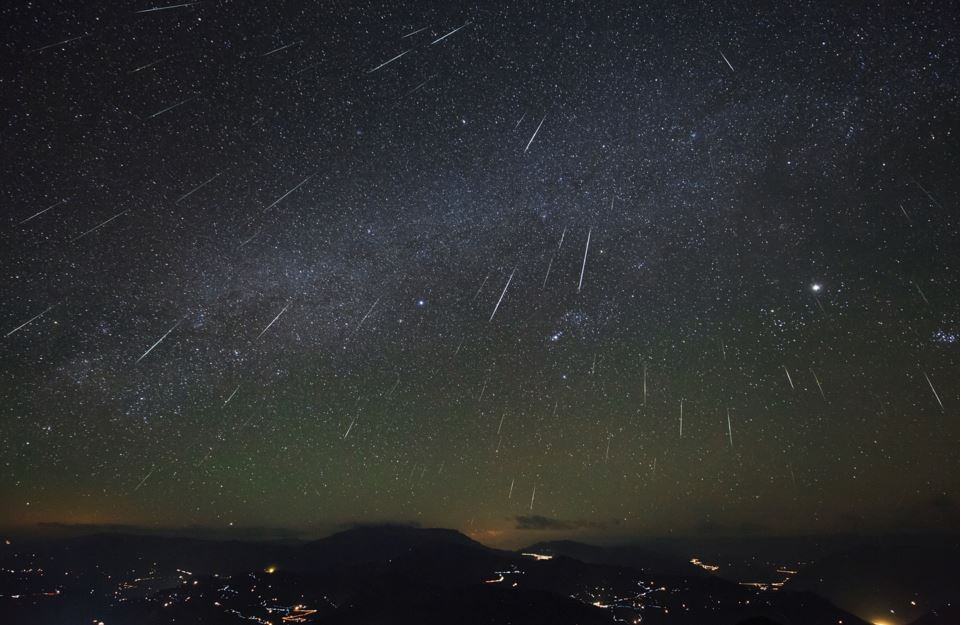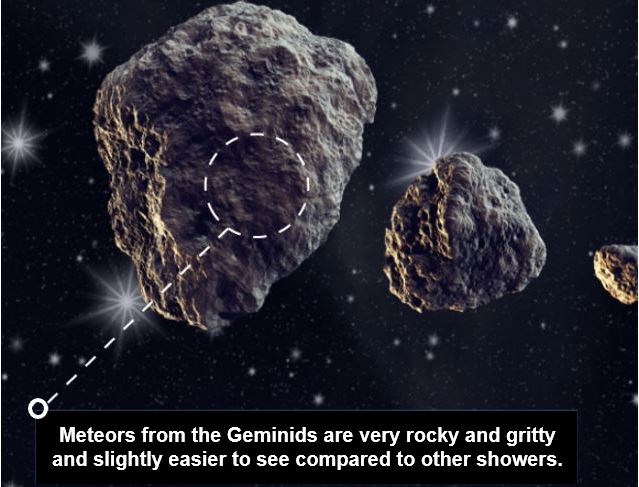The spectacular Geminid Meteor Shower, which comes as regular as clockwork at this time of year, peaks on Sunday and Monday, the 13th and 14th of December, according to Britain’s Met Office, which says stargazers will enjoy the show of at least 50 meteors per hour brightly whizzing across the sky. The US space agency NASA, however, says up to 120 meteors per hour are visible during this peak period.
Earth, as it always does at this time of year, is going through the trail of debris left by the Palladian asteroid 3200 Phatheon, which was discovered by the Infrared Astronomical Satellite on 11th October, 1983. This trail of debris creates the Geminid Meteor Shower when rocks burn up in Earth’s atmosphere.
Unlike most other meteor showers which come from comets, the Genimids, as well as the Quadrantids, are the only major meteor showers originating from asteroids. Debris from asteroids are very gritty and rocky, which means they are easier to see in the sky with the naked eye.
 Of the many meteor showers that occur every year, the Geminid Meteor Shower in December is probably the most reliably active. Recorded near the peak on December 14, 2012, this skyscape captured many of Geminid’s beautiful shooting stars. The careful composite of exposures was made during a 3 hour period overlooking the Dashanbao Wetlands in central China. (Image: http://apod.nasa.gov)
Of the many meteor showers that occur every year, the Geminid Meteor Shower in December is probably the most reliably active. Recorded near the peak on December 14, 2012, this skyscape captured many of Geminid’s beautiful shooting stars. The careful composite of exposures was made during a 3 hour period overlooking the Dashanbao Wetlands in central China. (Image: http://apod.nasa.gov)
Amateur astronomers love the Geminids because they streak vividly across the sky at about 35 kilometres per second (22 mps) annually at about the same time. According to astronomers, the shower is becoming more intense each year.
Geminid Meteor Shower difficult to miss
The Geminids are difficult to miss – when they come all you need to do is look up. There is no need to try and locate the Gemini constellation to catch the spectacle. Even though the meteors start at that constellation, they will streak across the entire sky brightly. You can’t miss them!
According to NASA, they can appear nearly anywhere in the night sky, and usually have a yellowish hue.
Remember that you will need warm clothes if you are going to be outdoors, perhaps lying down in a cold December night. All you will need are keen eyes and a clear sky.
On its website, the Met Office says:
“Starting on 4 December and ending on the 17 December, the Geminid meteor shower is for most, the highlight of the meteor shower calendar in 2015. The best time to view the Geminids is between sunset, local time and before sunrise.”
“Star gazers will be looking for clear, cloudless skies to have the best possible chance of catching a glimpse of the meteor shower. Ideally a location away from light pollution will be of benefit.”
 The Geminids originate in Gemini, one of the constellations of the zodiac. It was one of the 48 constellations described by Claudius Ptolemy (c. AD 100 – c. 170), a Greco-Egyptian writer, mathematician, astronomer, geographer, astrologer, and poet. Its name means ‘twins’ in Latin, and is associated with the twins Pollux and Castor in Greek mythology. (Image: science.nasa.gov)
The Geminids originate in Gemini, one of the constellations of the zodiac. It was one of the 48 constellations described by Claudius Ptolemy (c. AD 100 – c. 170), a Greco-Egyptian writer, mathematician, astronomer, geographer, astrologer, and poet. Its name means ‘twins’ in Latin, and is associated with the twins Pollux and Castor in Greek mythology. (Image: science.nasa.gov)
According to NASA, the Geminid Meteor Shower will peak during daylight on December 14th. However, you can still enjoy a super show on the nights of the 13th and 14th, from about 9pm to 10pm.
The Houston Museum of Natural Science says that the Geminids were first spotted in 1862. At that time they were not particularly spectacular events, with just ten to twenty meteors per hour. Since then they have intensified and become one of the most important night-sky shows of the year.
Viewing tips for the Geminid Meteor Shower
The Geminids are best viewed during the night and pre-dawn hours. They can be seen across the whole world due to an almost 24-hour broad maximum.
 The Geminid Meteor Shower originates from an asteroid, not a comet, like most other major meteor showers do. (Image: UK Met Office)
The Geminid Meteor Shower originates from an asteroid, not a comet, like most other major meteor showers do. (Image: UK Met Office)
The show is a great opportunity for young budding astronomers, because it occurs not too late in the evening, from 9pm to 10pm.
You will get better results if you find a spot far away from street or city lights. NASA’s Jet Propulsion Laboratory has the following advice for ultra-keen amateur astronomers:
“If you enjoy camping, try planning a trip that coincides with dates of one of the meteor showers listed below. Once you get to your viewing location, search for the darkest patch of sky you can find, as meteors can appear anywhere overhead.”
NASA says it is best to look up lying flat on your back with your feet facing south. After about thirty minutes, your eyes will become adapted to the dark and you will start seeing meteors. A ground pad or reclining chair will make it far more comfortable to keep your gaze focused on the night sky.
NASA’s Jet Propulsion Laboratory added:
“Put away the telescope or binoculars. Using either reduces the amount of sky you can see at one time, lowering the odds that you’ll see anything but darkness. Instead, let your eyes hang loose and don’t look in any one specific spot.”
“Relaxed eyes will quickly zone in on any movement up above, and you’ll be able to spot more meteors. Avoid looking at your cell phone or any other light. Both destroy night vision.”
Of all the debris streams our planet passes through annually as it orbits the Sun, the Geminids are by far the most massive, astronomers say.
The Geminid stream has from 5 to 500 times more dust and rocks than those of other meteor showers.
Met Office Video – Geminid Meteor Shower
This Met Office video was released last year, when December 13th and 14th fell on Saturday & Sunday. This year, December 13th and 14th fall on Sunday & Monday.
